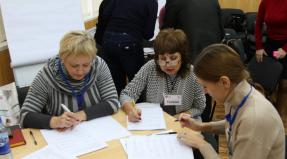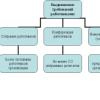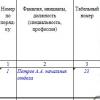Shchutskyyulian konstantinovich. A real Renaissance man Julian Shchutsky
On his father's side he came from the Jagiellonian-Czartorysk family. My father was a forestry scientist. Mother is a music teacher. After graduating from the orphanage of the Prince of Oldenburg, he entered the Economics Department of the Petrograd Polytechnic Institute. In 1914 he visited Germany, France and Switzerland. Since 1920 he worked at the Asian Museum of the USSR Academy of Sciences (since 1930 - the Institute of Oriental Studies of the USSR Academy of Sciences). In 1921 he graduated from the ethnological and linguistic department of the Faculty of Social Sciences of Petrograd University in the Department of Sinology.
He studied and later taught at the Leningrad Oriental Institute, V.M. Alekseev later singled him out among the three best students of the institute. In the early 1920s, he was a member of one of the Petrograd anthroposophical circles. In May 1923 he read the report "Confession of Tao by Ge Hong" in the category of India and the Far East of the RAIMK. In the 1924-1925 academic year, he began to teach the course "Introduction to Daology" at Leningrad State University.
In 1920, he began working at the Asian Museum of the Academy of Sciences, where he worked his way up from a researcher of the 3rd category to a scientific curator of the museum, and then, after the reorganization of the museum in 1930 into the Institute of Oriental Studies of the Academy of Sciences of the USSR, he became a scientist and s. 1933 - Scientific Secretary of the Chinese Cabinet of the Institute.
In 1928, on the recommendation of V.M. Alekseeva Yu.K. Shchutsky was sent by the Academy of Sciences to Japan to acquire Japanese and Chinese books and to familiarize himself with the research activities of Japanese Sinologists. He stayed in Japan for four and a half months, living in Osaka at a Buddhist temple. Together with B.A.Vasiliev (1899-1946), another outstanding student of V.M. Alekseev, in 1934 he wrote a textbook of the Chinese language (baihua).
He was a member of the temporary commission on the Latinization of Chinese writing at the All-Union Central Committee of the New Alphabet and constantly participated in the work of a group for the study of syntax at the Leningrad Research Institute of Linguistics. The most significant result of his linguistic research was the article "Traces of stages in Chinese hieroglyphics" (1932).
In 1936-1937. was an employee of the State Hermitage, where N.V. Alabyshev worked in the department of numismatics until 1933.
He spoke Chinese, Japanese, Korean, Vietnamese, Manchu, Burmese, Thai, Bengali, Hindustani, Sanskrit, Arabic, Hebrew, German, French, English, Polish, Dutch and Latin. For the first time in Russia, he introduced the teaching of the Guangzhou (Cantonese) dialect of the Chinese language and the Vietnamese language. Together with B. A. Vasiliev(1899-1938) wrote a Chinese textbook. After the death of Shchutsky, Vietnamese studies in the USSR ceased to exist for a long time.
Known mainly for the classical translation and interpretation of the "Book of Changes" - one of the canons of the Chinese pentateuch. Shchutsky defended his study of the Book of Changes two months before his arrest as a doctoral dissertation. His translation and research of the "Book" (published in 1960) is recognized as one of the most fundamental Sinological works of the 20th century. In 1979 the book was translated into English language and published in the USA and England.
In August 1937, he was arrested on charges of "espionage" and sentenced to death. He was shot in February 1938. His co-author B. A. Vasiliev was arrested on September 6, 1937, charged on November 19, and shot on November 24 in Leningrad "on the same day with a number of other orientalists." In a number of publications of the Soviet era, the wrong date of death is indicated - 1941 or 1946. He was on the staff of the Institute of Oriental Studies until 1943.
Officer's street (now Dekabristov street), house 9, apt. 2. On March 21, 2015, a memorial sign “
Yu.K. Shchutsky. Chinese Classical Book of Changes I Ching
Text prepared by: Vladimir Alpert
Introduction
This introduction is addressed to the non-scholarly reader. It is necessary as a kind of guide to the work proposed below, it should guide the reader in issues, without taking into account which the Book of Changes itself will not be understandable and, moreover, it will not be clear why the author took up the translation and study of the monument, there are so few the speaker's first glance to the modern reader. In addition, it is in this introduction that the basic terminology of the monument should be given and explained, which will be constantly used below and which cannot be dispensed with in the special work on the "Book of Changes".
We undertook this work because, while studying materials on the history of Chinese philosophy, we were constantly faced with the need to preface the research of each philosophical school with preliminary studies of the "Book of Changes" - the main and starting point of reasoning of almost all philosophers of ancient China.
The Book of Changes ranks first among the classic books of Confucianism and in bibliographic reviews of Chinese literature. This is understandable, since bibliology and bibliography in feudal China were created by people who received a traditional Confucian education. The bibliographers of old China unshakably believed in the tradition (not original, but old enough) that dated the creation of the "Book of Changes" to such a deep antiquity that no other classical book could compete with it in chronological primacy, although in fact the "Book of Changes" is not the most the oldest of the monuments of Chinese writing, and this was established by Chinese philology.
However, regardless of tradition, regardless of Confucianism, "The Book of Changes" has all the rights to the first place in Chinese classical literature, so great is its importance in the development of the spiritual culture of China. She exerted her influence in various fields: in philosophy, and in mathematics, and in politics, and in strategy, and in the theory of painting and music, and in art itself: from the famous plot of ancient painting - "8 horses" - to the spell inscriptions on a coin amulet or ornament on a modern ashtray.
Not without annoyance, but also not without pleasure, we must give the "Book of Changes" undoubtedly the first place among other classical books and as the most difficult of them: the most difficult both to understand and to translate. The Book of Changes has always enjoyed the glory of a dark and mysterious text surrounded by a huge, sometimes very diverging literature of commentators. Despite the grandeur of this two-thousand-year literature, understanding some passages of the "Books of Changes" still seems to be almost insurmountable difficulties - so unusual and alien to us are the images in which its concepts are expressed. Therefore, let the reader not complain to the writer of these lines, if some places in the translation of this monument do not turn out to be clear at the first reading. One can console oneself only with the fact that in the Far East the original "Book of Changes" is not understood as simply as other Chinese classical books.
To help the reader as much as we can, we will focus here on our work plan, on external description the contents of the "Book of Changes" and in its most important technical terminology.
Our work is divided into three parts: the first of them sets out the basic data achieved during the study of this monument in Europe, China and Japan. The second part is a succinct summary of the data we obtained from the study of thirteen major problems associated with the "Book of Changes". The third part is devoted to translations of the book.
The text of the "Book of Changes" is heterogeneous both from the side of its constituent parts, and from the side of the written signs themselves, in which it is expressed. In addition to the usual hieroglyphs, it also contains special icons consisting of two types of traits, xiao. One type represents whole horizontal lines: they are called yang (light), gan (tense), or most often, according to the symbolism of numbers, tszyu (nines). Another type of trait is horizontal lines interrupted in the middle: they are called yin (shadow), zhou (pliable), or more often, according to the symbolism of the numbers lu (six). Each icon contains six such traits, placed in very different combinations, for example:, etc. According to the theory of the Book of Changes, the entire world process is an alternation of situations resulting from the interaction and struggle of the forces of light and darkness, tension and compliance, and each of these situations is symbolically expressed by one of these signs, of which there are only 64 in the Book of Changes. They are regarded as symbols of reality and are called gua (symbol) in Chinese. In European Sinology literature, they are called hexagrams. Hexagrams, contrary to the norm of the Chinese writing, are written from bottom to top, and in accordance with this, the counting of features in the hexagram starts from the bottom. Thus, the first line of the hexagram is considered to be the lower one, which is called the initial one, the second line is the second from below, the third is the third from below, etc. The upper line is not called the sixth, but the upper line (shan). Traits symbolize the stages of development of a particular situation, expressed in a hexagram. The places from the lower, initial, to the sixth, upper, which occupy the lines, are called wei (positions). Odd positions (initial, third and fifth) are considered to be the positions of light - yang; even (second, fourth and top) - positions of darkness - yin. Naturally, only in half of the cases the light line turns out to be in the light position and the shadow one - on the shadow one. These cases are called the "appropriateness" of the traits: in them the power of light or darkness "takes its place." This is generally seen as a favorable disposition of forces, but not always considered the best. Thus, we get the following scheme: Positions Names Predisposition
6 Upper Dark
5 Fifth Light
4 Fourth Darkness
3 Third Light
2 Second Darkness
1 Initial Light
Thus, the hexagram with the complete "appropriateness" of traits is the 63rd, and the hexagram with the complete "inappropriateness" of the traits is the 64th.
Already in the oldest commentaries to the "Book of Changes" it is indicated that initially eight symbols of three lines, the so-called trigrams, were created. They received specific names and were attached to specific circles of concepts. Here we indicate their styles and their main names, properties and images.
From these concepts one can conclude how the process of emergence, existence and disappearance was considered in the theory of the "Book of Changes". The creative impulse, plunging into the environment of meon - performance, acts primarily as the excitement of the latter. Then comes his complete immersion in meon, which leads to the creation of the created, to his stay. But since the world is a movement, a struggle of opposites, then gradually the creative impulse recedes, the creative forces are clarified, and further, by inertia, only their cohesion is preserved for some time, which eventually comes to the disintegration of the entire situation, to its resolution.
1.qian (creativity) fortress sky
2.kun (execution) dedication earth
3.zhen (arousal) mobility thunder
4.canh (immersion) danger water
5.gen (abiding) the firmness of the mountain
6.sun (thinning) wind penetration
7.Is (grip) clarity fire
8.dui (permission) joyfulness of the pond
Each hexagram can be seen as a combination of two trigrams. Their mutual relationship characterizes this hexagram. At the same time, in the theory of the "Book of Changes" it is generally accepted that the lower trigram refers to the inner life, to the coming, to the created, and the upper to the external world, to the retreating, to the disintegrating, ie.
Outward, receding, crumbling
Inner, coming, being created
In addition, the hexagram is sometimes viewed as consisting of three pairs of traits. According to the theory of the "Book of Changes", there are three cosmic potencies in the world - heaven, man, earth:
There is also the symbolism of the individual positions of the hexagram developed in the fortune-telling practice of the Ijinists.
In society: 1. Commoner; 2. Serving; 3. Nobleman; 4. The courtier; 5. King; 6. Perfect man.
In the human body: 1. Feet; 2. Shins; 3. Hips; 4. Torso; 5. Shoulders; 6. Head.
In the body of the animal: 1.Tail; 2. Hind legs; 3. The back of the body; 4. Front of the body; 5. Front legs; 6. Head.
Julian Konstantinovich Shchutsky- orientalist; Doctor of Philology, professor,born on 23 August 1897. V1922 he graduated from Petrograd University with a degree in Sinology. This is followed by a rich research and teaching work in various scientific and educational organizations.In 1935 he received the degree of candidate of philological sciences without defense. Doctoral dissertation: "Chinese classical" Book of changes. Experience of philological research and translation "(completed in 1935, published in 1960). Shchutsky began his study of Taoism in 1922 by translating and commenting on Ge Hong's treatise (IV century) "The Teacher Embracing Simplicity" ("Baopu Tzu"). He studied in detail the fundamental categories "Tao" and "Te", their relationship, Taoist-Buddhist syncretism, problems of the classical text "Le Tzu". In 1924-1925 he began to teach the course "Introduction to Daology" at the Leningrad University.In 1937 he prepared a monographic study "The Book of Changes" ("I Ching"), which is the basis of Chinese philosophical thought. He viewed the worldview of The Book of Changes as a complete system. I was ready to begin a series of monographic studies on the philosophers Lao Tzu, Le Tzu, Chu-an-Tzu and Wang Yang-ming. In the history of Russian philosophy, Shchutsky remained as the founder of "Yi Jin studies" and a pioneer in the study of Taoism.
Julian Konstantinovich Shchutskyperfectly knew Japanese and Chinese languages, up to dialects, as well as languages of other peoples of the East .. Many European languages as well as Latin. Was on a business trip in Japan, where he lived at a Buddhist temple.
From left to right: Konrad, Vasiliev, Alekseev, Shchutsky. Konrad, a friend and neighbor of Academician Alekseev, was arrested in 1938. Kitists Boris Aleksandrovich Vasiliev and Yulian Konstantinovich Shchutsky, the best students of Alekseev, were arrested in 37th and both were shot
V.M. Alekseev and Yu.K. Shchutsky. 1925
I look into myself with countless eyes
Planets and moons and icy stars
And I rush into myself with all-colored rays,
I am building a bridge not made by hands.
Now burned by lightning, then by candles,
I faded and poured into a bunch
Done with swords and speeches.
The past is behind me a cometary tail ...
And rejoicing, from the vastness of the world,
I fall and fly into the sun
And the past is my gunpowder comet
Explodes in sheaves, of which
The melted twin of the soul rises
Like the echo of the thunder of the cherubic choirs.
Everything was. Everything is given. But everything is declining.
Built with wisdom - the world fell to dust.
And the will of substance was enchanted by the pipes,
Sounding like thunder in the Divine worlds.
And the demon of decay, clothed in rude
And a deceitful cloak of substances, forgetting about gifts,
Scares us children, showing teeth,
And the coldness of spaces gives rise to fear in souls.
But remember that minds live in your mind
All stars and all planets, all suns, lands and moons.
Study the harmony of the substance with patience,
And in a harmonious chorus of stars, put words for them.
Touch the paths of the planets like silvery strings -
And the Light will then explode the plains of darkness.
ShchutskyYu.K.
In 1937, Shchutsky brilliantly defended his doctoral dissertation on the monograph "The Chinese Classical" Book of Changes ", completed two years earlier. A August 3, 1937Julian KonstantinovichShutsky was arrested and convicted on the infamous 58article.Shchutskywas declared a member of the "anarcho-mystical terrorist" organization "Order of the Knights Templar" and on the night of 17-18 February 1938was shot.
So the life of an outstanding scientist ended ...But his unsurpassed work lives on. The Book of Changes in its significance for both Chinese and world culture is on a par with the Bible, Avesta, Aristotle's Code ...
This is an extremely important historical monument, reflecting the worldview of the ancient Chinese, both in philosophical and worldview and in everyday life.

On his father's side he came from the Jagiellonian-Czartorysk family. My father was a forestry scientist. Mother is a music teacher. In his youth, the future Sinologist was fond of music. In 1915-1923. wrote a number of pieces of music. "Strong musical talent" Yu. K. Shchutsky was noted by his teacher, Academician V. M. Alekseev. According to N. Yu. Gryakalova, who published a previously unknown donation inscription by A. A. Blok, testifying to the poet's acquaintance with Yu. K. Shchutsky, the Archive of Orientalists of the St. Petersburg branch of the Institute of Oriental Studies of the Russian Academy of Sciences preserved manuscripts of several romances, the music to which was written by Yu. K. Shchutsky. In 1914, Yu. K. Shchutsky visited Germany, France and Switzerland. Since 1920 he worked at the Asian Museum of the USSR Academy of Sciences (since 1930 - the Institute of Oriental Studies of the USSR Academy of Sciences). In 1921 he graduated from the ethnological and linguistic department of the Faculty of Social Sciences of Petrograd University in the Department of Sinology. In the early 1920s, he was a member of one of the Petrograd anthroposophical circles. In May 1923 he read the report "Confession of Tao by Ge Hong" in the category of India and the Far East of the RAIMK. In the 1924-1925 academic year, he began to teach the course "Introduction to Daology" at Leningrad State University.
In 1928 he was sent to Japan by the Academy of Sciences of the USSR. In 1936-1937 he was an employee of the State Hermitage.
In August 1937, he was arrested on charges of "espionage" and sentenced to death; shot in February 1938. A number of Soviet period publications indicate the wrong date of death - 1941 or 1946. He was on the staff of the Institute of Oriental Studies until 1943.
Scientific activity
He spoke Chinese, Japanese, Korean, Vietnamese (Annam), Manchu, Burmese, Siamese (Tai), Bengali (Bengali), Hindustani, Sanskrit, Arabic, Hebrew, German, French, English, Polish, Dutch and Latin. For the first time in Russia, he introduced the teaching of the Guangzhou (Cantonese) dialect of the Chinese language and the Vietnamese language. Together with B.A.Vasiliev (1899-1938) he wrote a textbook of the Chinese language. After the death of Shchutsky, Vietnamese studies in the USSR ceased to exist for a long time.
Known mainly for the classical translation and interpretation of the "Book of Changes" - one of the canons of the Chinese pentateuch. Shchutsky defended his study of the Book of Changes two months before his arrest as a doctoral dissertation. His translation and research of the "Book" (published in 1960) is recognized as one of the most fundamental Sinological works of the 20th century. In 1979 the book was translated into English and published in the USA and England.
In 1922 he made a translation of Ge Hong's treatise Baopu-tzu, now lost. On this occasion, his teacher V.M. Alekseev dedicated the following comic poem to Shchutsky from only monosyllabic words, imitating Chinese poetry:
He is shaved, the cheeks are silk - mat.
The eye is small - the look is so sharp ...
Fra Schutz is a monster among us:
Ge Hong was crushed by him.
Shchutsky and E. I. Dmitrieva
In 1922, in Petrograd, 25-year-old Shchutsky met 35-year-old Ye. I. Dmitrieva (by her husband Vasilyeva), known as the heroine of the famous hoax - "Cherubina de Gabriak". A number of poems by Dmitrieva are addressed to Shchutsky. Since 1911 E.I. Dmitrieva devoted herself to anthroposophy. As one of the leaders of the St. Petersburg Anthroposophical Society, she often traveled to Germany, Switzerland and Finland on social affairs. Apparently, this was the reason for the persecution she suffered in the 1920s.
On the way to a Japanese business trip in the fall of 1927, Shchutsky stopped by the exiled Dmitrieva in Tashkent, and on his advice she created a cycle of poems on behalf of the Chinese poet Li Xiang Tzu ("the sage from the house under the pear tree"; her first pseudonym was "Ye Li" ), exiled to a foreign land. On the way back, shortly before Dmitrieva's death, in September 1928, Shchutsky also visited her.
In 1935, he recalled Elizabeth: “The late E.I. Despite the fact that years have passed since her death, she continues to be the center of my consciousness as a moral and creative ideal of a person. " Subsequently, it was the Japanese business trip of 1927-1928. became one of the reasons for the execution of Shchutsky as a "spy".
Addresses in Petrograd - Leningrad
Officer's street (now Dekabristov street), house 9, apt. 2.
Essays
- Shchutsky Yu.K. Taoist in Buddhism. - Eastern Notes, vol. 1, L., 1927
- Shchutsky Yu.K. The main problems in the history of the text "Le Tzu". - Notes of the College of Orientalists, vol. 3, no. 2, 1928
- Shchutsky Yu.K. Traces of stadiality in Chinese hieroglyphics. - Japhetic collection, vol. 3, L., 1932
- Shchutsky Yu.K. Doctoral dissertation. Chinese classic "Book of Changes". Experience in philological research and translation. L., 1937
- Shchutsky Yu.K. Chinese classic "Book of Changes". M., 1960, 1992, 1993, 1997
- Shchutsky Yu.K. Tao and Te in the books of Lao Tzu and Chuang Tzu. - From magical power to moral imperative: the category of te in Chinese culture. M., 1998
- Shchutskii, Iulian. Researches on the I Ching. Princeton: Princeton University Press, 1979. Translated from the Russian by William MacDonald and Tsuyoshi Hasegawa
Julian Konstantinovich Shchutsky was born on August 23, 1897 in Yekaterinburg. In 1921 he graduated from the Ethnological and Linguistic Department of the Faculty of Social Sciences of Leningrad State University in the Department of Sinology, where he studied Chinese language and literature under the guidance of V.M. Alekseev, N.I. Konrad, O.O. Rosenberg. In 1923, the scientist, together with V.M. Alekseev, published the "Anthology of Chinese Lyrics of the VIII-IX centuries." Since 1920, Yu.K. Shchutsky worked at the Asian Museum of the Academy of Sciences, went from a researcher of the 3rd category to a scientific curator of the museum. After the transformation of the museum into the Institute of Oriental Studies of the Academy of Sciences in 1930, he became a scientist, and since 1933 - the scientific secretary of the Chinese cabinet of the institute. In 1935, without defending a thesis, he was awarded the title of candidate of linguistics, in 1935 Shchutsky became a professor, and in 1937 - a doctor of philological sciences. In 1936-1937. he collaborated at the State Hermitage Museum. Yu.K. Shchutsky was a polyglot, he spoke many languages: Chinese, Japanese, Korean, Vietnamese (Annam), Manchu, Burmese, Siamese (Tai), Bengali (Bengali), Hindustani, Sanskrit, Arabic, Hebrew, German, French, English, Polish, Dutch, Latin. Together with B.A. Vasiliev he wrote a textbook of the Chinese language. He is also known as a philosopher and anthroposophist. In August 1937, Julian Shchutsky was arrested on charges of espionage and sentenced to "10 years in camps without the right to correspond" (which essentially meant execution), posthumously in the late 1950s he was rehabilitated. The translation and research by Yu.K. Shchutsky "I Ching" ("Books of Changes") - this work was published in 1960 - is recognized as one of the most fundamental Sinological works of the twentieth century; in 1979, the scientist's book was translated into English and published in the USA and England.
In our library you can download all the books by Julian Shchutsky for free.



















